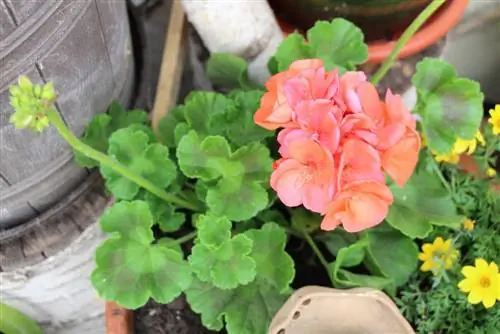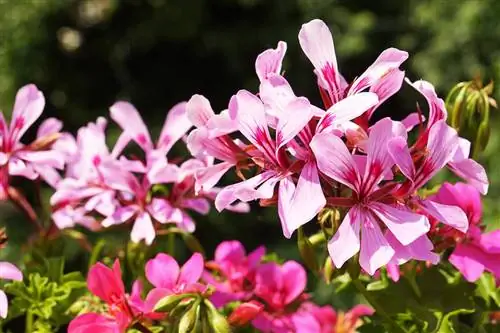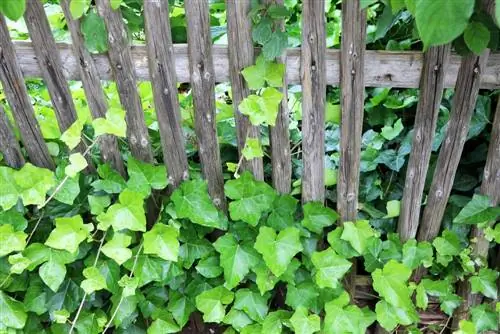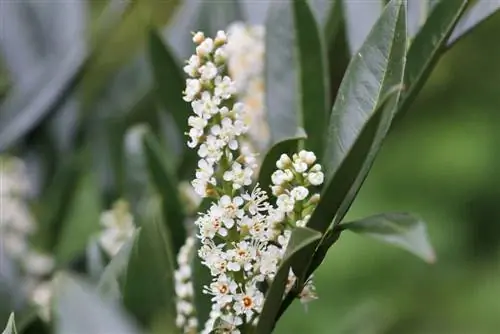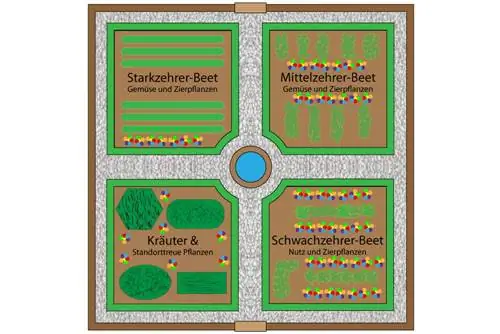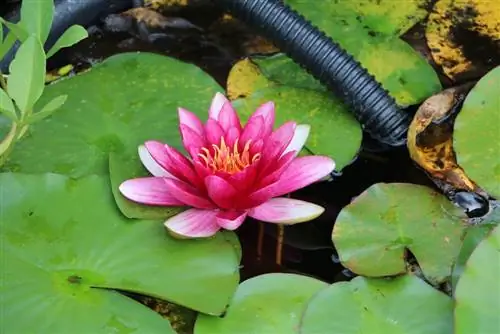- Author admin [email protected].
- Public 2023-12-17 03:39.
- Last modified 2025-01-24 12:45.
A beautiful old zinc tub makes a great decoration for the terrace or garden. These tubs were previously mostly used for washing or bathing. Nowadays, however, they are also made for purely decorative purposes and are therefore found in many sizes and designs. Of course, an old tub that, with a bit of luck, can be found at a flea market is particularly interesting.
Preparing the zinc tub
A zinc tub that is to be planted and that is in an uncovered location and is therefore exposed to the rain definitely needs holes so that excess water can drain away. These holes are best drilled in both the bottom and the sides. Shards of pottery or similar material should be placed on the holes in the ground before the soil is filled. This will prevent the drain holes from becoming clogged over time.
Alternatively, a layer of gravel can first be filled into the zinc tray and covered with a garden fleece. Although this fleece is permeable to water, it is not permeable to the potting soil and thus prevents the drainage holes from becoming blocked. So that the rainwater can easily drain downwards, it is also helpful to place the tub on small wooden blocks or stones so that there is a gap between the tub and the floor.
Suitable plants for the zinc tub
Basically, all plants that do not form roots that are too deep are suitable for planting in a zinc tub. Flowering plants such as daisies, geraniums or petunias as well as green plants can be used for this. Onion plants that are placed in a zinc tray in autumn provide beautiful decoration and some color in the garden in spring. They can be combined beautifully with evergreen plants such as ivy.
Year-round planting is possible with hardy perennials or with evergreen plants such as heather or dead nettle. Some grasses with different leaf colors ensure that the tub is beautiful to look at even in autumn. Pansies and horned violets tolerate frost and bloom almost all year round. The sedum and houseleek are very easy to care for, but usually quite small, and the ornamental cabbage is suitable for the winter.
Beautiful pebbles or other decorative items between the plants loosen up the look a little. When planting a zinc tub, however, it should be borne in mind that the plants cannot supply themselves with the necessary nutrients. The potting soil should therefore be replaced every now and then or enriched with a fertilizer.
The zinc tub as a herb bed
So that the planted zinc tub is not only decorative but also practical, any kind of herbs or vegetable plants can be planted in it. Mediterranean herbs such as thyme, oregano, lavender and rosemary look particularly beautiful. In this case, special attention should be paid to ensuring good drainage, as these herbs do best on relatively dry soil due to their origin.
Inspection and preparation of the zinc pan
Zinc is a material that can prove to be very durable in the garden, as it can basically last a century without you having to give it any care. However, this does not necessarily apply to planted zinc containers, and not every zinc tub should be spontaneously planted.
First, a critical look and, if necessary, further measures are recommended: If you, for example,For example, if you have purchased a battery of beautiful zinc tubs from a garden store, you should make sure that these zinc containers have drainage holes before placing plants in them. Very often this is not the case - these zinc pots are only intended to be used indoors as a planter. If that's exactly what you plan to do, you should add drainage at the bottom (in a collecting container, see below), otherwise your plants would always be standing in water once you've watered a little generously.
If you want the zinc tub to reveal its nostalgic charm outdoors, you don't need to worry about putting a closed plant pot in it. However, the pot then needs a drainage layer in the lower area. However, when installed in the garden, the disadvantage is that the zinc tub fills with water every time it rains heavily (or if it is under the lawn sprinkler) up to the level of the drainage layer. You would then have to lift out the plant pot and tip out the water collecting container so that the water does not eventually run directly into the interior of the zinc tray. You don't have this disadvantage if you plant the zinc tub directly, but other difficulties arise:
- It doesn't work without drainage, most plants take offense at that. Of course, you would now basically have the option of simply drilling drainage holes in the zinc tray, but this in turn has consequences: No flower container is made entirely of zinc, but rather of galvanized steel, which is supposed to be protected from corrosion by the zinc alloy.
- Depending on the age of the material, drilling can be more or less damaging. With newer containers that have been made largely water-resistant using special coating processes, you would break through the protective layer, which will not be good for the zinc in the long run. In the case of an old zinc tub, the hole would not reduce the durability, but only because it is limited anyway due to constant contact with moisture.
You should therefore only plant directly in a zinc tub that you know has a water-resistant alloy and has drainage holes. All other zinc tubs whose alloy you don't know actually need drainage at the bottom, which is placed in a container that keeps the water escaping from the plant pot as far away from the zinc as possible.
- For this purpose you could e.g. B. use a plant pot that has a slightly larger diameter than the planted pot that is to be used and shorten the edge of it so that it can no longer be seen in the zinc tray. Water that has rained in can then be removed with a tolerable effort.
- Another solution would be a large foil bag filled with gravel at the bottom of the zinc tub. If too much water gets into this structure, draining it will be work.
- But if you just want to plant an old zinc tub that you found in the attic, you could drill holes in it with the drill, plant it and then wait until it dissolves at some point
because this won't happen overnight: the soil comes into contact with moisture the most, so it dissolves first, which will definitely take a few years. The walls of the tub are not nearly as exposed to moisture as the floor because excess moisture can seep down. They will therefore most likely stay with you for a very long time, and it doesn't really matter to you whether the floor is still there or not.
Planting tips
However, such a zinc tub that is destined to last forever needs either an annual or a winter-proof planting - if the soil is in the process of dissolving, it is difficult to move it. Overwintering in another location is therefore not possible. When the soil rusts away, the garden soil underneath becomes enriched with zinc and iron oxide, which does no harm.
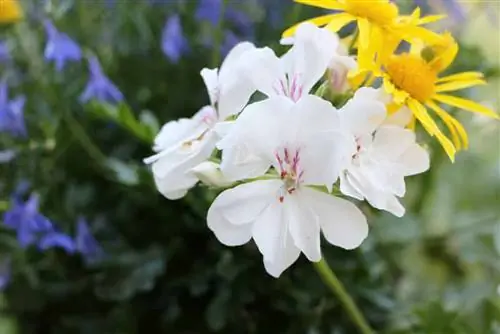
It is much more likely that you will improve your soil with additional zinc and iron: The pH value of normal garden soil should be almost in the neutral range (6.5 to 7.5), with a pH value between 6, 3 and 6, 8 all nutrients are well absorbed. However, both zinc and iron are absorbed even better if the soil is slightly acidic - normal garden soil can therefore usually use a little additional zinc and iron.
Substrate and plants for the zinc tub
This also means that you should not add acidic soil to a directly planted zinc tray in order to plant acid-loving plants such as azaleas. At some point these would perhaps get too much zinc or iron. If you want the zinc tub to always stay in one place, you then have to choose the right plants for that location. You can of course plant whatever you want in a zinc tray that is shielded from moisture. The soil goes into the separate plant pots, and the location can also change.
Conclusion of the editors
A zinc tub can be wonderfully planted with a little knowledge of the material, whether just for the season or permanently. However, caution is always advised if a zinc tub is to be planted directly and there is a lot of moisture involved. That's why the frequently propagated idea of using the zinc tub as a decorative mini pond is actually not that good: To ensure that water directly in the tub doesn't cause corrosion, the coating must be of considerable quality.
It would be possible, however, to place a water container made of water-resistant material in a zinc tub and surround it with soil and plants.

